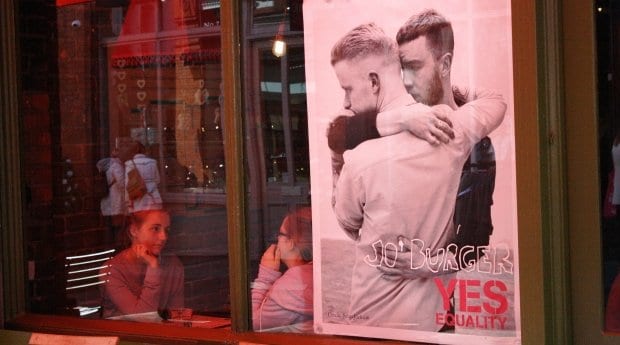“I find myself getting quite emotional when I talk about it,” Damian tells me as he’s ordering a pint at The George, one of Dublin’s most popular gay bars. We’re both here for a 5,000-euro bingo fundraiser for Yes Equality; a campaign that hopes to legalize same-sex marriage in Ireland’s upcoming referendum. “I think everyone thinks we’ll win, but what if we lose?”
The question hang in the air. In a nation known for its friendliness and hospitality, Ireland’s queer community is loath to contemplate the implications of a nationwide vote to deny its basic equality.
It’s Sunday night, 12 days before the May 22 vote. Four of the country’s top drag queens are revving up the crowd with high-energy dance numbers interspersed with witty take-downs of the No campaign’s talking points. The bar is packed with supporters wearing the Yes campaign’s hashtag-emblazoned t-shirts, boasting about what they’ll do with if they’ve got the lucky bingo card.
In the end, the night’s prize is claimed by a young man in a green T-shirt with the Gaelic Yes slogan, “Tá Comhionannas,” who donates half his winnings back to the cause.
———
Ireland’s government first announced its intention to legalize same-sex marriage in 2013, but a referendum was required to insulate the law from a constitutional challenge. The Irish Constitution doesn’t explicitly define marriage, but does require the government to respect and protect the family as the basic unit of society.
Polls put public opinion in a range from 60–80 percent in favour of equal marriage.
Under the same section of the constitution, divorce was explicitly prohibited until it was legalized by referendum in 1995. That referendum squeaked by with only 50.28 percent of the vote and was the second attempt at a divorce amendment.
Few expect the equal marriage referendum to be that close: polls put public opinion in a range from 60–80 percent in favour of equal marriage. But Yes campaigners remain concerned that the polls may overestimate support and that the vote could lose on low turnout. Ireland created civil partnerships for same-sex couples in 2010, but as these are not constitutionally recognized, queer couples are still barred from all of the rights and benefits of marriage. It was only in April 2015, that the government passed a bill allowing gay couples to adopt.
———
Judging by the sign war in central Dublin, the Yes side is winning by a wide margin.
On lampposts along the Liffey river, “Yes Equality” signs are only challenged for visibility by similarly affirmative ones. The country’s entire political class has lined up in favour of the referendum, and every major political party has its own brand of “Yes” signs strewn around the city — the better to claim credit for the victory if the referendum wins.
Businesses throughout the core, including the iconic Temple Bar nightlife scene, are strewn with “business for equality” window decals, original posters and pro-gay murals.
Notable Irish celebrities have also come out as Yes supporters, including Colin Farrell, Bono, Colm Tóibín and Aidan Gillen.
But outside of the city, you’d be forgiven for not knowing a referendum was happening. Tourist towns like Glendalough and Kilkenny have few signs at all.
By contrast, the No campaign was barely visible in the capital until a sign blitz began in the final week of the campaign. A few small signs competed for attention, and many of those within easy reach had been vandalized. “No” signs are somewhat more prevalent along the highways into the suburbs.
Yes dominance is mirrored on social media, where “Yes Equality” has gathered 56,000 Facebook likes and dominates discussion using the #MarRef hashtag. By contrast, the No campaign’s “Mothers and Fathers Matter” page has earned around 6,000 likes, and virtually no one is tweeting under No’s #KeepMarriage hashtag.
That hasn’t stopped the No side from using their campaign literature, signs and websites to insinuate that gay couples are unfit parents and to stoke fears about commercial surrogacy (which is already legal under Irish law). A few accuse the Yes side of being bullies.
But the Yes campaign’s message is also curious. Posters don’t say the words “gay” or “same-sex,” or depict gay people. Few even say “marriage.” Instead they appeal to voters to support “equality” and oppose “discrimination,” perhaps a semantic trick to win the support of those who get queasy about homosexuality.
———
Ireland’s equal marriage campaign is unique — it’s the only country in the world to hold a referendum on legalizing same-sex marriage, although a handful of US states held equal marriage referendums, and a number of countries and US states have held referendums to ban same-sex marriage.
As such, queer activists from around the world are watching Ireland. Several European countries, for example, have constitutional bans on same-sex marriage and would require referendums to undo them. There is early discussion that Switzerland may hold an equal marriage referendum this year, and that Slovenia may be forced to hold a referendum to affirm its recently-passed equal marriage law.
Additionally, because a special protocol to the European Union’s (EU) Lisbon Treaty prevents EU human rights laws from contradicting the Irish Constitution’s sections on the family, some speculate that a Yes vote is a necessary precursor to an eventual EU direction requiring recognition of same-sex marriages throughout the 28-member bloc. Sixteen EU members currently ban same-sex marriage.
———
Both the Yes and No campaigns are officially working under Irish law that restricts their budgets to money raised in Ireland and donated by Irish citizens during the election period, although both were active long before the referendum officially began. Both sides regularly accuse each other of being funded by pro-gay or anti-gay groups from the US and EU.
Irish people now know that there are gay and lesbian people living in every town and village.
The Iona Institute, a private Catholic lobby group, is behind much of the No campaign’s messaging on radio and television panels. Accusations of pro-equality bias against the public broadcaster RTÉ — and a successful defamation suit after RTÉ labelled the Institute “anti-gay” — have forced the station to scrupulously “balance” its programming by presenting anti-equality viewpoints in equal number to pro-equality voices. In a bizarre episode, Aodhan O’Riordain, the government minister of state for equality, was forced to remove a small “Yes” pin in the middle of a live television chat show in the interest of balance.
Despite this, the Yes campaign is staying positive and getting its message heard, often through direct, personal interaction.
Ireland’s population of 4.5 million live in a country the size of New Brunswick, making it possible for a small team to have a wide impact. A “Yes Equality Bus” is trying to reach every corner of Ireland during the election period, with a planned 66 stops in all 26 counties over 27 days.
Marriage Equality co-director Moninne Griffith says the Yes campaign has been greeted with open arms across the country.
“We haven’t found that the rural-urban thing is a big difference. What’s happened over the past five years, as gay and lesbian people are more visible in their communities, Irish people now know that there are gay and lesbian people living in every town and village in Ireland,” she says. “People are standing up for their community and standing up for their friends and families.”
Canvassers aboard the bus at a stop in the Dublin suburb Blanchardstown say they’re hearing from the majority of people that they plan to vote Yes, but they occasionally encounter strong resistance.
“We put up posters on our house and someone put our own wheelie bin through our window,” says Kevin Griffith, a 19-year-old student canvasser. “That doesn’t get covered in the media, but they cover all these No posters getting painted over, people talk like it’s the worst thing ever. I don’t agree with people punting over posters, but it’s not like the No side is innocent. That’s really violent and I don’t think the Yes side has been violent at all.”
While there’s a lot of excitement at the prospect of the referendum passing, the young canvassers are still worried that No will prevail.
“I actually don’t know how I’ll walk down the street looking at people, knowing that they voted that I don’t belong here. If I feel like the majority don’t want me to be here, I don’t know if I want to be here anymore,” Griffith says.
“I love the country, I just feel like I don’t know if I’d be able to trust it anymore if it didn’t go through. Just to know that the majority of people don’t care,” echoes 18-year-old canvasser Dearbaile Keown.
Ireland goes to the polls on Friday, May 22.


 Why you can trust Xtra
Why you can trust Xtra


